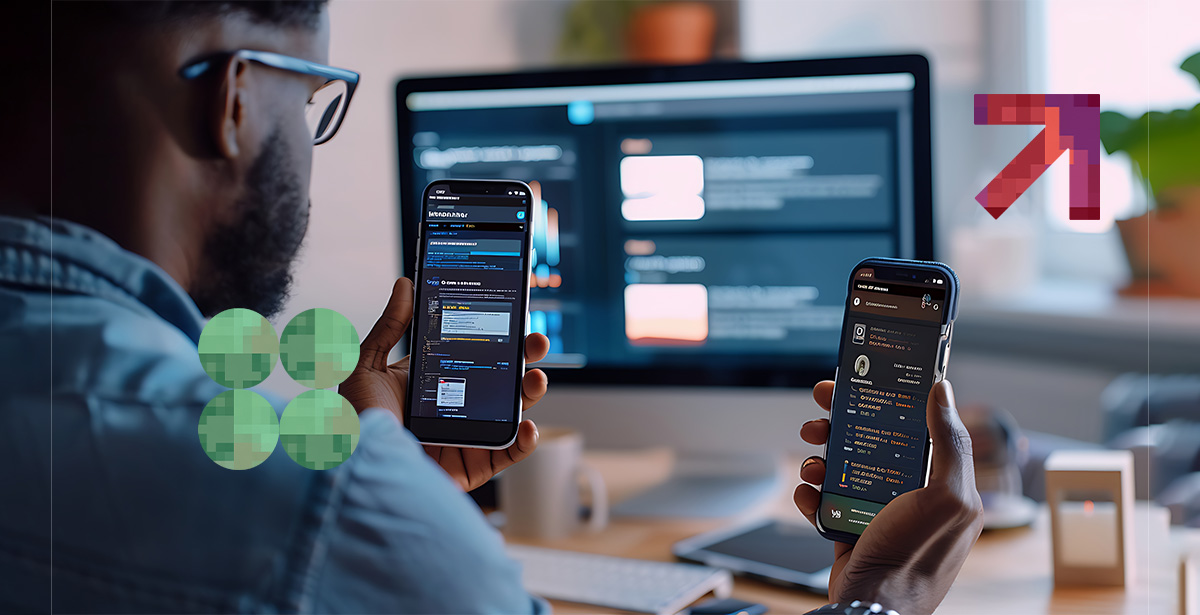Video Streaming App Development – A First Timer’s Guide

Video streaming isn’t the future; it’s the now. With its global market expected to hit $184.3 billion by 2027, only the bold and proactive will carve out a lasting presence.
Even if you take a closer look locally, you’ll notice that video content consumption in Tama is high. According to Advertise in Tampa, around 1.7 million adults in Tampa Bay consume video content weekly. And 95.2% of households in the area have devices connected to streaming TV.
So, whether you’re eyeing new revenue streams or building the next binge-worthy platform, the opportunity is massive. Unfortunately, so is the competition.
That’s why you need to understand everything there is to video streaming app development to confidently nab your share of the market.
Video Streaming Apps 101: What They Are and Their Types
Video streaming apps transmit video content over the internet using streaming protocols, enabling real-time or on-demand playback without downloading content.
These apps can be categorized as –
- Video on Demand (VOD) – These apps offer a library of pre-recorded content accessible anytime. A good example of this is Netflix.
- Live Streaming – This type of app broadcasts content in real-time for events, gaming, or webinars. And Twitch is a good example.
- Over-the-Top (OTT) Platforms – OTT platforms deliver premium content over the internet, bypassing cable. Hulu and Prime Video are two prominent examples, both in Tampa and worldwide.
- Video Hosting Platforms – These apps allow users to upload and share videos. And as you may have guessed, YouTube and Vimeo fall under this category.
- Niche or Vertical Streaming Apps – These apps target specific audiences or genres like fitness (Peloton) or education (MasterClass).
- Enterprise Streaming Apps – Enterprises, too, can benefit from internal training, communication, or virtual events. A popular example is Microsoft Stream.
- Social Media Apps with Video Features – These apps showcase short-form and live video such as Instagram.
Whether you’re planning a B2C app or an internal enterprise platform, identifying the type is the first building block of your product strategy.
💡 Need more custom enterprise application development ideas? Here’s one – AI-powered enterprise apps. AI empowers you to leverage machine learning for predictive analytics, automate workflows, and enhance decision-making. You can even integrate NLP for smarter customer interactions or have AI-driven insights to streamline operations and boost overall efficiency.
Stream Your Way: Benefits of Live Streaming App Development
Video streaming app development is more than just a tech experiment; it’s a strategic investment that pays off in different ways. Here are some of the advantages you can expect.
1) Full Ownership of User Data and Behavioral Insights
When you build a streaming platform, you gain unrestricted access to your users’ behavioral and engagement data.
This data, ranging from demographics to retention patterns, empowers you to make informed, data-driven decisions. Unlike third-party platforms that restrict or monetize access to user analytics.
This level of transparency can directly shape your growth trajectory and sharpen your competitive edge.
2) Greater Scalability and Technical Freedom
Owning your platform means you’re no longer limited by the technical roadblocks or update cycles of external providers.
You can innovate at your pace, add new features based on user feedback, and integrate any third-party service without restrictions.
This flexibility enables long-term scalability and fosters a faster, more agile product roadmap.
3) Cost Control and Elimination of Hidden Fees
Many third-party platforms charge based on traffic, making budgeting unpredictable, especially when you’re growing fast.
On the other hand, custom streaming platforms let you scale user access without being penalized with unexpected fees per viewer or usage tier. This, in turn, ensures a smoother path to profitability.
4) Enhanced Branding and Differentiation
Building a branded experience gives you a major edge over generic streaming platforms.
Video streaming app development allows you to fully align the design, voice, and feel of your service with your brand identity. This results in stronger brand recognition and loyalty.
Moreover, this distinct presence helps your offering stand out in a saturated market and builds long-term user trust.
5) Seamless Usability and Global Accessibility
Developing your video streaming app lets you design for intuitive usability and seamless navigation, tailored to your audience’s needs. You also get to control global accessibility, ensuring content is available across regions, devices, and connection types.
This expands your reach and enhances user satisfaction across diverse markets.
6) A More Resilient and Diverse User Acquisition Strategy
Relying solely on third-party platforms for visibility is risky. Outages or policy changes can drastically impact your reach.
However, launching your own platform reduces dependency and enables you to gain new acquisition channels via search engines, app stores, and direct engagement.
This adds resilience to your business model and improves your ability to scale sustainably.
7) Direct Revenue Generation Through Custom Monetization
Owning a video streaming app allows you to implement monetization models that align with your business strategy.
Subscriptions, ads, pay-per-view, or hybrid models give you full control over how revenue flows in. And you won’t need to split profits with third-party platforms. You own the pipeline, and you set the terms.
Steps for Effective Video Streaming Application Development
Creating a video streaming app takes more than just content; it requires a sharp strategy, solid tech, and a user-focused approach.
Here are the steps you should take to build a high-performing product.
Step 1) Validate the Idea and Define the Niche
Before jumping into video streaming app development, make sure that your app solves a real problem for a clearly defined audience. A well-defined niche and a validated idea increases your chances of building a relevant and profitable app.
Research user behavior, competitor platforms, and market trends to confirm your idea solves a specific demand or fills a content gap. Then, narrow down your niche to target a focused audience.
Step 2) Decide if You Want Video Streaming as a Feature or a Dedicated Solution
Determine whether video streaming will be a core offering or just one part of a broader platform.
Your decision at this stage directly impacts the app’s architecture, resource allocation, and long-term maintenance. So, make sure it aligns with your business model and growth goals.
If it’s a feature, like in social media or e-learning apps, it should integrate seamlessly with other functions. If it’s the core product, your architecture should prioritize content delivery performance, modular design, and concurrent user scalability.
Step 3) Choose the Right Monetization Model
Monetization defines how your video streaming app will generate revenue and sustain growth.
The most common monetization approaches include –
- Subscription (SVOD), which is Ideal for platforms offering ongoing or premium content access
- Transactional (TVOD), a model where users pay for individual pieces of content, and is suited for movies, episodes, or short series
- Pay-per-View, which is the approach used commonly for one-time events like live concerts
- Ad-Supported (AVOD) for generating income through targeted ads
- Freemium, which offers basic access for free while charging for advanced features or exclusive content
- In-App Monetization where in-app purchases occur, mainly through Apple/Google stores if targeting mobile
Your app can also support more than one approach at a time. For instance, it can offer subscription and show ads to free users.
Whatever you decide on, make sure to plan your infrastructure to support these models from day one.
Step 4) Define the Core Technology Stack and Infrastructure
Your technology stack forms the foundation of your video streaming app development success.
Choose front-end and back-end frameworks tailored to your target platforms, be t web, mobile, or cross-platform. Implement a high-performance media server, secure streaming protocols, and scalable cloud infrastructure to support smooth video delivery.
Integrate a content delivery network (CDN) to ensure fast, buffer-free playback across global regions. Include essential components like video encoding, storage solutions, real-time analytics, and database management.
In addition to boosting performance and scalability, a well-structured stack ensures your app is ready to handle rapid growth and user demand.
💡 Pro Tip! Smart tooling is the backbone of successful streaming mobile app development. The right tech stack ensures your app runs fast, scales smoothly, and delivers top-tier user experience. Explore the five must-have tools when considering enterprise mobile application development; don’t build without them.
Step 5) Build a Prototype and Focus on User Experience
Develop a functional prototype to validate your app’s concept and core features before full-scale development.
Prioritize intuitive navigation, responsive design, and a clutter-free interface to ensure a smooth user experience.
You should also test key features like video playback, search functionality, user registration, and recommendation engines early on. And don’t forget to gather user feedback to refine the interface and user flow.
Ensuring the above will help you identify usability issues, reduce development risks, and align the product with user expectations.
Step 6) Secure Content Rights and Ensure Legal Compliance
Before launching, it’s critical to secure licensing agreements for all video content to avoid copyright issues.
Legal groundwork is a crucial part of video streaming app development; it protects your business and builds trust with providers and users. It further ensures that your app operates safely, ethically, and within the boundaries of the law.
Whether you’re streaming original productions or third-party media, obtain proper distribution rights.
Moreover, comply with regional regulations, data protection laws, and copyright standards. Also, consider incorporating digital rights management (DRM) to prevent unauthorized access or piracy.
Step 7) Launch, Track Performance, and Iterate
After launching your video streaming app, focus on gathering user feedback and monitoring key metrics like buffering time, viewer retention, and session length.
Use analytics tools to track performance, identify bottlenecks, and understand user behavior. You should also prioritize quick bug fixes and optimize based on real-world usage. Finally, continuously test new features, improve UI/UX, and adapt to market trends.
Iteration is essential for maintaining engagement, staying competitive, and ensuring your app evolves with user expectations and technology advancements.
🔥 Hot Tip! Think building a video streaming app development is just about getting the tech stack right? Not quite. Like any business application, you’ll face challenges that don’t show up in beginner tutorials like shifting user needs, infrastructure limitations, or compliance headaches. Here’s a quick breakdown of common hurdles you might run into when developing a custom business software solution and why tackling them early can save your launch.
Let’s Create That Video Streaming App for You
Breaking into the streaming space isn’t easy. But with the right video streaming app development company, it’s absolutely doable.
Whether you’re launching a niche VOD app or integrating live video into your product, DPL brings the tech, speed, and strategy to make it happen.
Let’s build something your users can’t stop watching. Fill out the form below.




